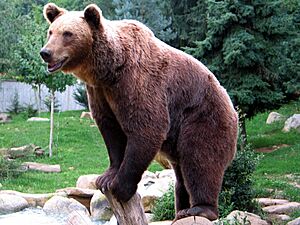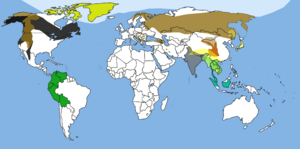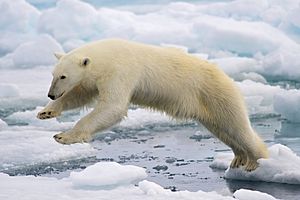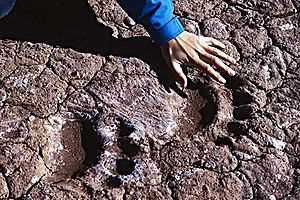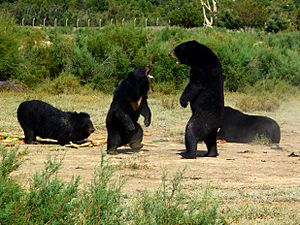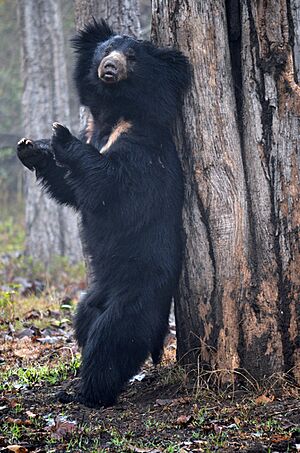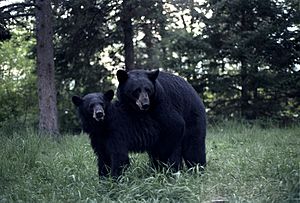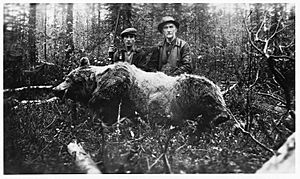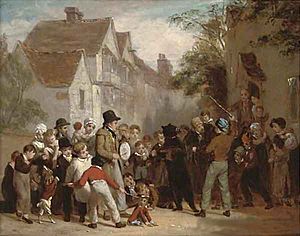Bear facts for kids
Quick facts for kids BearTemporal range: late Eocene – Recent
|
|
|---|---|
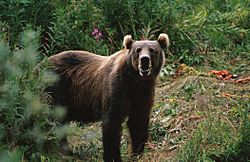 |
|
| A Kodiak brown bear | |
| Scientific classification | |
| Kingdom: | |
| Phylum: | |
| Class: | |
| Order: | |
| Suborder: | |
| Family: |
Ursidae
|
| Genera | |
Bears are large, furry mammals that belong to the family called Ursidae. They are part of a group of meat-eating animals known as carnivorans, specifically the "dog-like" ones. Even though there are only eight types of bears alive today, they live in many different places around the world. You can find them in various habitats across the Northern Hemisphere and even in parts of the Southern Hemisphere. Bears live on the continents of North America, South America, Europe, and Asia.
Most modern bears share some common features. They have big bodies with strong, short legs, long noses, and small, round ears. Their fur is usually shaggy, and they walk on their whole foot, like humans do. They have five claws that they cannot pull back, and their tails are short.
While polar bears mostly eat meat, and giant pandas eat almost only bamboo, the other six types of bears are omnivores. This means they eat both plants and animals, and their diets can be quite different.
Bears usually like to be alone. They can be active during the day or at night, and they have an amazing sense of smell. Even though they look heavy and walk a bit awkwardly, bears are good at running, climbing, and swimming. They often use caves or hollow logs as their homes, called dens. Most bears in colder areas stay in their dens for a long time during winter, a period called hibernation, which can last up to 100 days.
People have hunted bears for their meat and fur since ancient times. Bears were also used for entertainment, like bear-baiting or being trained to dance.
Contents
What's in a Name?
The word "bear" in English comes from an old English word, bera. It's related to other words for bears in Germanic languages, like the Swedish word björn. These words all come from an older word that meant "brown."
How Bears Evolved Over Time
The bear family, Ursidae, is one of nine families in the "dog-like" group of carnivorans. Bears' closest living relatives include seals, sea lions, dogs, and animals like weasels and badgers. Today, there are eight species of bears, divided into three main groups: the giant panda, the spectacled bear, and the group that includes six other bear species.
Ancient Bears: A Look Back in Time

The very first members of the bear family were quite different from bears today. They were small and looked more like raccoons. These early bears lived about 38 to 18 million years ago. They probably ate food similar to what badgers eat.
One of the oldest known relatives of modern bears was a raccoon-sized, dog-like animal called Cephalogale. It first appeared in Europe and Asia about 30 million years ago.
The short-faced bears of North and South America, like the spectacled bear, separated from other bears about 13 million years ago. They moved into South America about 1 million years ago when the Isthmus of Panama formed.
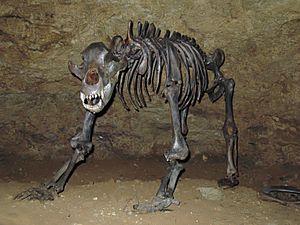
The sloth bear is a modern bear that comes from one of the earliest bear groups, about 5.3 million years ago. It developed its unique look and diet of termites and ants by the early Pleistocene epoch. About 3 to 4 million years ago, a bear species called Ursus minimus appeared in Europe. It looked very much like today's Asian black bear, except for its size. This bear is likely the ancestor of all bears in the main bear group, except maybe the sloth bear.
Two main groups of bears developed from U. minimus: the black bears (including the sun bear, Asian black bear, and American black bear) and the brown bears (which include the polar bear). Modern brown bears came from U. minimus through another ancient bear called Ursus etruscus, which was also the ancestor of the extinct Pleistocene cave bear. Bears from the main group have traveled to North America from Europe and Asia many times, starting as early as 4 million years ago. The polar bear is the newest bear species, evolving from the brown bear about 400,000 years ago.
Bear Family Tree
Bears form a special group within the carnivorans. The red panda is not a bear; it's more closely related to weasels. Scientists use genetic information to figure out how animals are related. The giant panda and the spectacled bear are clearly the oldest bear species. The relationships between the other bear species are still being studied, but the polar bear and the brown bear are very closely related.
| Ursidae |
|
||||||||||||||||||||||||||||||||||||||||||
What Bears Look Like
Bear Size and Weight
Bears are some of the biggest land animals in the carnivore group. The largest are polar bears, which can weigh up to 1,600 pounds (726 kg). The smallest bears are the sun bears of Asia, weighing up to 150 pounds (68 kg).
A bear's weight changes throughout the year, especially in places with changing seasons. They gain a lot of fat in summer and autumn to prepare for winter, and then lose weight during the colder months. Their body length can range from about 5 feet (150 cm) for sun bears to 8 feet (244 cm) for polar bears.
Bear Body Features
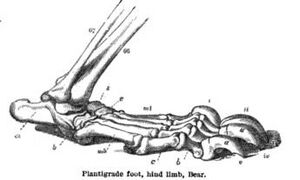
Bears are generally large and strong animals with short tails. Male bears are usually bigger than females. Because they rely on strength more than speed, bears have short, thick legs to support their heavy bodies. Their strong front legs are used for catching prey, digging dens, finding burrowing animals, flipping over rocks and logs, and hitting large creatures.
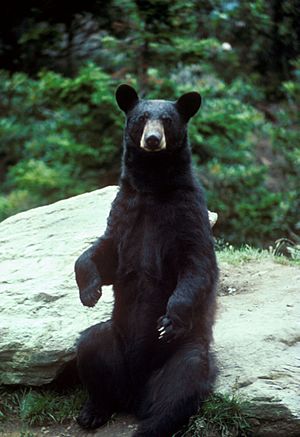
Unlike most other land carnivores, bears walk on their entire foot, like humans. This makes them look a bit clumsy when they walk. Their front paws are flexible enough to grab fruits and leaves. Bears' claws cannot be pulled back, and they use them for digging, climbing, tearing food, and catching prey.
A bear's shaggy fur helps keep it warm during winter hibernation. They shed this thick coat in the spring for a shorter summer coat. Polar bears have special hollow, see-through hairs that trap heat from the sun and send it to their dark skin underneath. They also have a thick layer of fat for extra warmth, and their footpads are covered in dense fur. Most bears are a single color, but some species have markings on their chest or face, like the black and white of the panda.
Bears have small, round ears to help them avoid losing body heat. Their hearing and eyesight are not super sharp. However, unlike many other carnivores, they can see in color, which might help them find ripe nuts and fruits.
Bear skulls are very big and strong. They provide a place for powerful jaw muscles to attach. Their canine teeth are large but mostly used for showing off. Their molar teeth are flat and good for crushing food.
Bears have a simple digestive system, typical for meat-eating animals, with just one stomach.
Where Bears Live and Their Homes

Today, bears live in sixty countries, mostly in the Northern Hemisphere, in Asia, North America, and Europe. The only exception is the spectacled bear, which lives in the Andean region of South America. The sun bear's home range extends south of the equator in Southeast Asia. The Atlas bear, a type of brown bear, used to live in North Africa but became extinct around the 1870s.
The brown bear is the most widespread species, living from Western Europe across Asia to western North America. The American black bear lives only in North America, and the polar bear lives only in the Arctic Sea. All other bear species are found in Asia. Bears live in many different kinds of places, including tropical rainforests, forests with pine trees or broadleaf trees, grasslands, mountains, Arctic tundra, and for polar bears, on ice floes. Bears might dig their dens in hillsides or use caves, hollow logs, and thick plants for shelter.
Bear Behavior and Life Cycle
Brown bears and American black bears are usually active during the day. However, they might also look for food at night. Other bear species might be active mostly at night. Female sloth bears with cubs sometimes feed more during the day to avoid other bears and night predators.
Most bears are solitary animals, meaning they prefer to be alone. They are considered the least social of all carnivores. The only times you might see bears in small groups are mothers with their cubs or when there's a lot of food available in one place, like during a salmon run.
What Bears Eat
Most bears are omnivores who eat whatever they can find. They usually eat more plants than animals. Their diet includes leaves, roots, berries, insects, dead animals, fresh meat, and fish. Their digestive systems and teeth are made for this varied diet. At one extreme is the giant panda, which eats almost only bamboo. At the other extreme is the polar bear, which eats mostly meat. However, all bears will eat any food that is available during different seasons. For example, Asian black bears in Taiwan eat many acorns when they are common, but switch to eating hoofed animals at other times of the year.
When bears look for plants, they choose them when they are most nutritious and easy to digest. They usually avoid older grasses and leaves. Brown bears, with their strong digging skills, often eat roots. The panda's diet is over 99% bamboo, from 30 different types of bamboo. Their strong jaws are perfect for crushing the tough stems of these plants, though they prefer to eat the more nutritious leaves. Certain plants called Bromeliads can make up to half of the spectacled bear's diet. These bears also have strong jaws to bite them open.
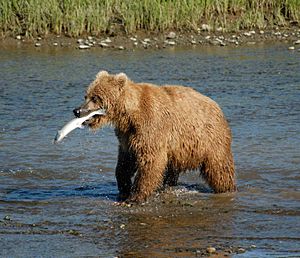
The sloth bear is not as specialized as polar bears or pandas. It has lost some front teeth and developed a long, sucking tongue to eat the ants, termites, and other burrowing insects it loves.
Brown bears and both types of black bears sometimes hunt large hoofed animals, like deer and cattle, especially the young or weak ones. They might ambush these animals with a quick rush. Hidden young animals can be sniffed out and pounced on. The polar bear mainly hunts seals, stalking them from the ice or breaking into their dens. They mostly eat the seals' fatty blubber, which is easy to digest. Large animals are usually killed with a bite to the head or neck. Young bears learn how to hunt from their mothers.
Bears are also great at finding and eating dead animals. They might steal food hidden by rodents or carcasses left by other predators.
For bears that hibernate, gaining weight is very important. It gives them the energy they need during their long winter sleep. A brown bear can eat 90 pounds (41 kg) of food and gain 4.5 to 6.5 pounds (2–3 kg) of fat each day before going into its den.
How Bears Communicate
Bears make many different sounds and body movements to communicate. They might click their tongues, grunt, or chuff when they are friendly, like mothers with cubs or courting pairs. When a bear is stressed, it might moan, huff, or blow air. Barking means they are alarmed, excited, or want to show where they are. Warning sounds include clicking jaws and popping lips. In aggressive situations, bears might chatter their teeth, bellow, growl, roar, or make pulsing sounds. Baby bears might squeal, bawl, bleat, or scream when they are in trouble. They make a motor-like humming sound when they are comfortable or nursing.
Bears also communicate by standing upright, which makes them look bigger. The chest markings on some bears might make this display even more impressive. Staring is a sign of aggression. The facial markings of spectacled bears and giant pandas might help draw attention to their eyes during fights. Bears might approach each other by walking stiff-legged with their heads down. A dominant bear will face another bear directly, showing its canine teeth, twisting its muzzle, and stretching its neck. A less dominant bear might turn sideways, drop its head, or sit or lie down.
Bears sometimes mark their territory by rubbing against trees and other objects. This helps spread their scent. They usually also claw and bite the object. They might even spread bark around to draw attention to the marked spot. Pandas are known to mark objects with urine and a waxy substance from their anal glands. Polar bears leave their scent in their tracks, which helps other bears find them in the huge Arctic wilderness.
Bear Reproduction and Life Cycle
During the time when bears mate, male bears notice females nearby, and females become more accepting of males. A male bear might stay with a female for several days or weeks, depending on the species, to see if she is ready to have cubs. During this time, males try to keep other male bears away from their mate. Courtship can be short, but in some Asian species, mating pairs might wrestle, hug, play-fight, and make sounds.
Pregnancy usually lasts 6 to 9 months, which includes a period where the embryo doesn't immediately attach to the womb. A mother bear can have up to four cubs. Giant pandas might have twins, but they can usually only feed one cub, so the other might not survive. In species that live in northern areas, cubs are born during the winter when the mother is hibernating.
Cubs are born blind and helpless, with very little hair. They depend on their mother for warmth. The mother bear's milk is rich in fat and antibodies, and cubs might drink her milk for up to a year after they are born. By 2 to 3 months old, cubs can follow their mother outside the den. They usually walk, but sloth bear cubs might ride on their mother's back. Male bears do not help raise the young.
In some species, cubs become independent around the next spring. However, some might stay with their mother until she mates again. Bears become ready to have their own cubs shortly after they leave their mother, usually around 3 to 6 years old, depending on the species. Male Alaskan brown bears and polar bears might keep growing until they are 11 years old. How long bears live also varies. The brown bear can live for about 25 years on average.
Winter Sleep: Hibernation
Bears in northern regions, like the American black bear and the grizzly bear, go into a deep sleep called hibernation during the winter. During hibernation, a bear's body slows down. Its body temperature drops a little, and its heart rate slows from a normal 55 beats per minute to just 9 beats per minute. Bears usually do not wake up during hibernation and can go the whole time without eating, drinking, or going to the bathroom. A plug forms in their intestines, which they get rid of when they wake up in the spring. If they have stored enough body fat, their muscles stay strong, and their bodies recycle waste to get the protein they need. Female bears give birth during hibernation and wake up to do so.
Who Hunts Bears?
Bears are at the top of the food chain, so they don't have many predators. Humans are their most significant predators. As people started farming, they often came into conflict with bears that raided their crops. With the invention of firearms, people could kill bears more easily. The tiger is the only four-legged animal that regularly hunts adult bears, including brown bears, sloth bears, Asian black bears, and sun bears.
Bears and Humans
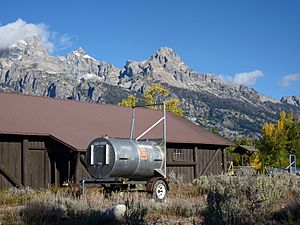
Protecting Bears
Today, bears face challenges because their homes are shrinking, and there's illegal trade in bear parts, especially for the Asian bile bear market. Hunting bears is now banned in many places, replaced by bear farming. The IUCN lists six bear species as vulnerable, meaning they are at risk. Even the two species that are doing better, the brown bear and the American black bear, are at risk of disappearing in some areas. These two species usually live in remote places with little human contact. The main non-natural causes of death for them are hunting, trapping, being hit by cars, and being killed by people protecting their property.
Laws have been passed in many parts of the world to protect bears from habitat destruction. People often have positive feelings about bears because bears eat many different foods, can stand on two legs, and are important symbols. Support for protecting bears is common, especially in wealthier countries. However, where bears raid crops or attack farm animals, they can cause problems for humans. In poorer rural areas, people's views might be more shaped by the dangers bears pose and the money they cost farmers.
Bear Attacks
Some bear species can be dangerous to humans, especially if they are used to being around people. In other places, bears generally avoid humans. Injuries caused by bears are rare, but they are often reported. Bears might attack humans if they are surprised, if they are protecting their cubs or food, or sometimes for hunting reasons.
Bears in Entertainment, Hunting, and Medicine
For centuries, bears kept in captivity have been used for entertainment. They have been trained to dance and were used for baiting in Europe since at least the 16th century. In London, there were five bear-baiting gardens at that time. Across Europe, nomadic Romani bear handlers, called Ursari, earned a living by performing with their bears since the 12th century.
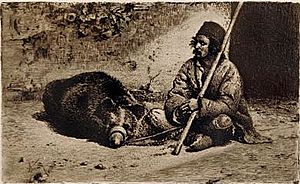
Bears have been hunted for sport, food, and folk medicine. Bear meat is dark and tough, similar to a tough cut of beef. In some cultures, like Cantonese cuisine, bear paws are considered a special dish. Bear meat should always be cooked very well because it can carry a parasite called Trichinella spiralis.
People in eastern Asia use bear body parts and fluids (especially their gallbladders and bile) as part of traditional Chinese medicine. More than 12,000 bears are believed to be kept on farms in China, Vietnam, and South Korea to produce bile. Trading bear products is against international rules, but bear bile has been found in shampoos, wine, and herbal medicines sold in Canada, the United States, and Australia.
Bears in Stories, Art, and Symbols
There is some evidence that people worshipped bears in ancient times. The ancient Finns, Siberian peoples, and more recently Koreans believed the bear was the spirit of their ancestors. There is also evidence of bear worship in early Chinese and Ainu cultures.
In many Native American cultures, the bear is a symbol of rebirth because it hibernates and then reappears in spring. The image of the mother bear was important in societies across North America and Europe/Asia, based on how devoted and protective female bears are of their cubs. Japanese folklore tells of the Onikuma, a "demon bear" that walks upright. The Ainu of northern Japan, who are different from the Japanese, saw the bear as sacred.
The constellations Ursa Major and Ursa Minor, the great and little bears, are named because they were thought to look like bears, a name given by Ptolemy long ago.
Artio was a Celtic bear goddess. Evidence of her worship has been found in Bern, a city named after the bear. Her name comes from the Celtic word for "bear," artos. In ancient Greece, an old tradition of worshipping Artemis in bear form continued into classical times.
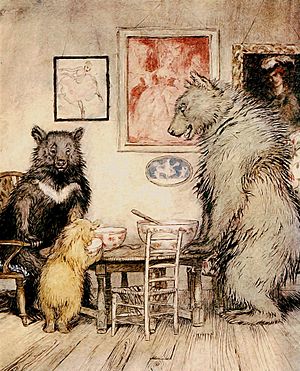
Bears are very popular in children's stories, including Winnie the Pooh, Paddington Bear, Gentle Ben, and "The Brown Bear of Norway". An early version of "Goldilocks and the Three Bears" was published in 1837 by Robert Southey. It has been retold many times and illustrated by artists like Arthur Rackham in 1918.
The cartoon character Yogi Bear has appeared in many comic books, animated television shows, and films. The Care Bears started as greeting cards in 1982 and became popular toys, clothing, and movie characters. Around the world, many children—and some adults—have teddy bears, which are stuffed toys shaped like bears. These toys are named after the American statesman Theodore Roosevelt. In 1902, he famously refused to shoot an American black bear that was tied to a tree.
The Russian Bear has been a common symbol for Russia since the 16th century.
Smokey Bear became a part of American culture after he was introduced in 1944, with his famous message: "Only you can prevent forest fires." In the UK, a bear and staff are on the official symbol of the county of Warwickshire. Bears also appear on the symbols of two cities, Bern and Berlin, because their names sound like "bear."
Organizations for Bears

Several organizations focus on bears. The International Association for Bear Research & Management, also known as the International Bear Association, and the Bear Specialist Group work on understanding, managing, and protecting bears. Bear Trust International works to help wild bears and other wildlife through programs like conservation education, wild bear research, wild bear management, and protecting their homes.
Related Pages
- Giant panda, Ailuropoda melanoleuca
- Spectacled bear, Tremarctos ornatus
- Brown bear, Ursus arctos
- Polar bear, Ursus maritimus
- American black bear, Ursus americanus
- Asian black bear, Ursus thibetanus or Selenarctos thibetanus
- Sloth bear, Melursus ursinus
- Sun bear, Ursus malayanus
Images for kids
-
The brown bear photographed near the Russian border in the forests of Kainuu, Finland.
-
American black bear tracks at Superior National Forest, Minnesota, U.S.
See also
 In Spanish: Osos para niños
In Spanish: Osos para niños


